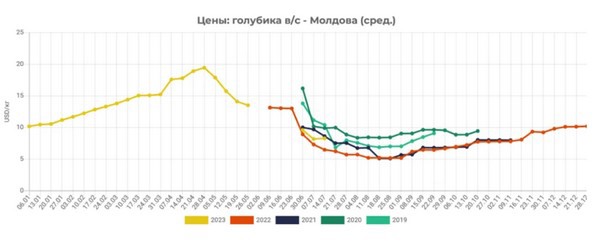It is no exaggeration to conclude that the Moldovan blueberry market has stagnated over the last three years. In the period 2018-2020, the level of wholesale prices at the beginning of the season (late June – early July) for this locally produced berry was 250-280 lei/kg ($14.84-16.16/kg), and by mid-July, did not fall below 175 lei/kg ($9.89/kg), while in the period 2021-2023, wholesale prices for Moldovan blueberries started from 170-180 lei/kg ($8.90-9.99/kg) and fell to 140-175 lei/kg ($7.29-9.68/kg) in a week or two. According to EastFruit, the average wholesale price for blueberries in the country is 150-155 lei/kg ($8.17-8.46/kg).
At the same time, in the past few years, the wholesale price for imported (mainly Romanian) blueberries in spring and early summer was at most 280-350 lei/kg ($-15.73-19.43/kg). In retail chains, the maximum price was 420 lei/kg ($23.3/kg). During the promotions and discounts, it dropped to 280 lei/kg ($15.73/kg). For comparison, in some supermarket chains, Latin American blueberries were offered at a price of 700-780 lei/kg during this period.

It is worth recalling that blueberries first appeared on the Moldovan market in 2016. It was a rare case of a Moldovan consumer getting acquainted with an exotic berry, not imported from far abroad, but grown by a local enterprise – “Lolly Berry” (in the Nisporeni district, which at that time had a plantation of 10 hectares, mainly of the varieties Duke and Bluegold). However, imported blueberries from Ukraine, Georgia, and Romania appeared in Moldovan retail as early as the next year. However, until 2018, the minimum wholesale price for imported and local blueberries at the lowest point of the summer season did not fall below 200 lei/kg ($10.82/kg).
Presumably, the fact that blueberries remained the most expensive “niche soft berries” in Moldova for three or four seasons prompted the owners of Lolly Berry to increase their blueberry plantation to 13 hectares. In addition, in 2018-2020, two more farms appeared in the country, growing blueberries on an area of at least 1-2 hectares and planning to expand them in the short term. Blueberry “micro plantations,” according to the Pomușoarele Moldovei Association of Berry Producers, are owned by small farms in some villages in the Nisporeni districts Calarasi, Glodeni. The total area of fruit-bearing blueberry plantations in Moldova is approaching 20 ha. Almost all blueberries grown in Moldova are sold on the domestic market.
According to expert estimates, in the last two or three years, the capacity of the Moldovan blueberry market has been approximately 800-900 tons per year, with at least half of this volume accounted for by imports (mainly from Romania).
For more information: east-fruit.com
